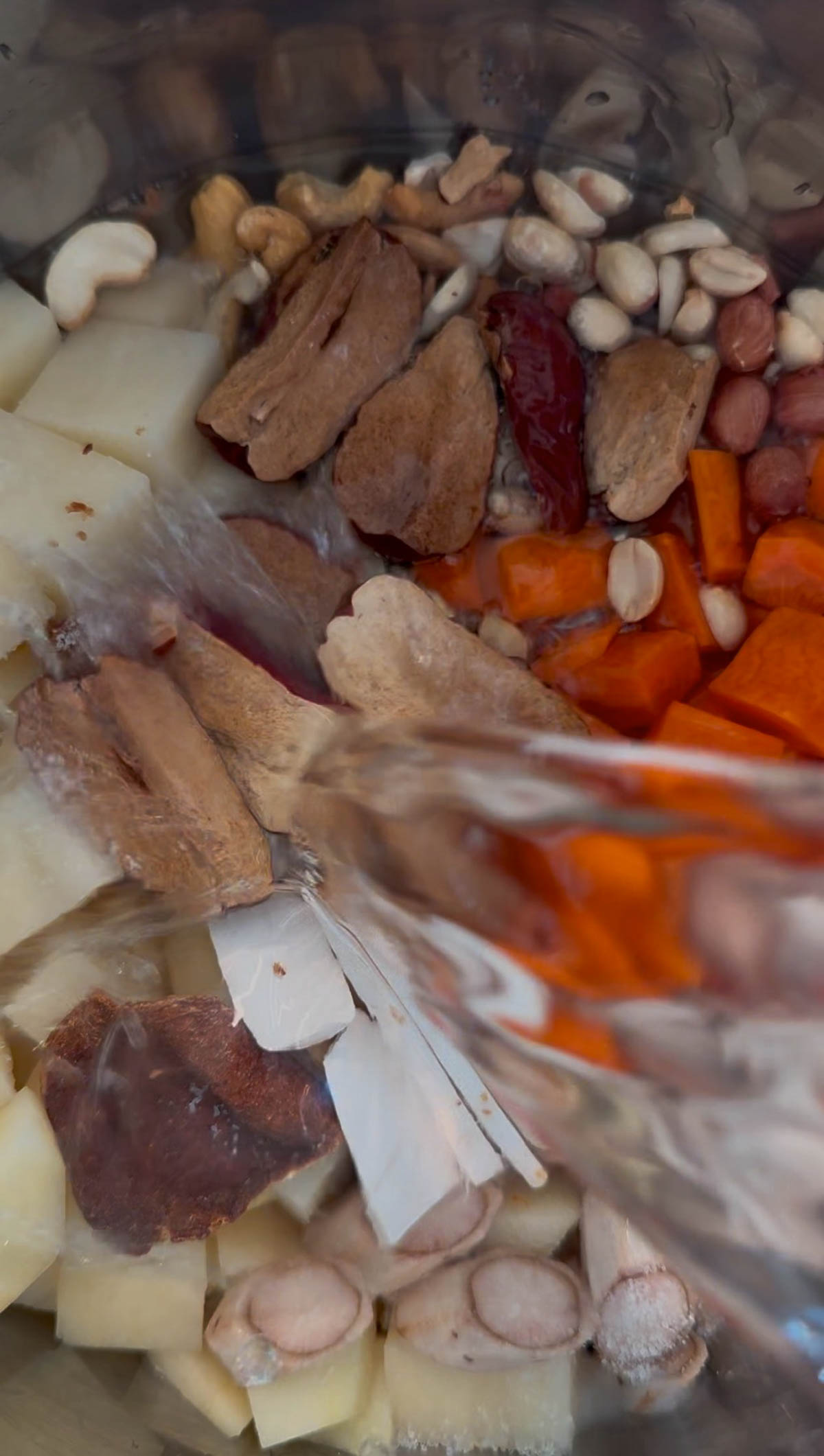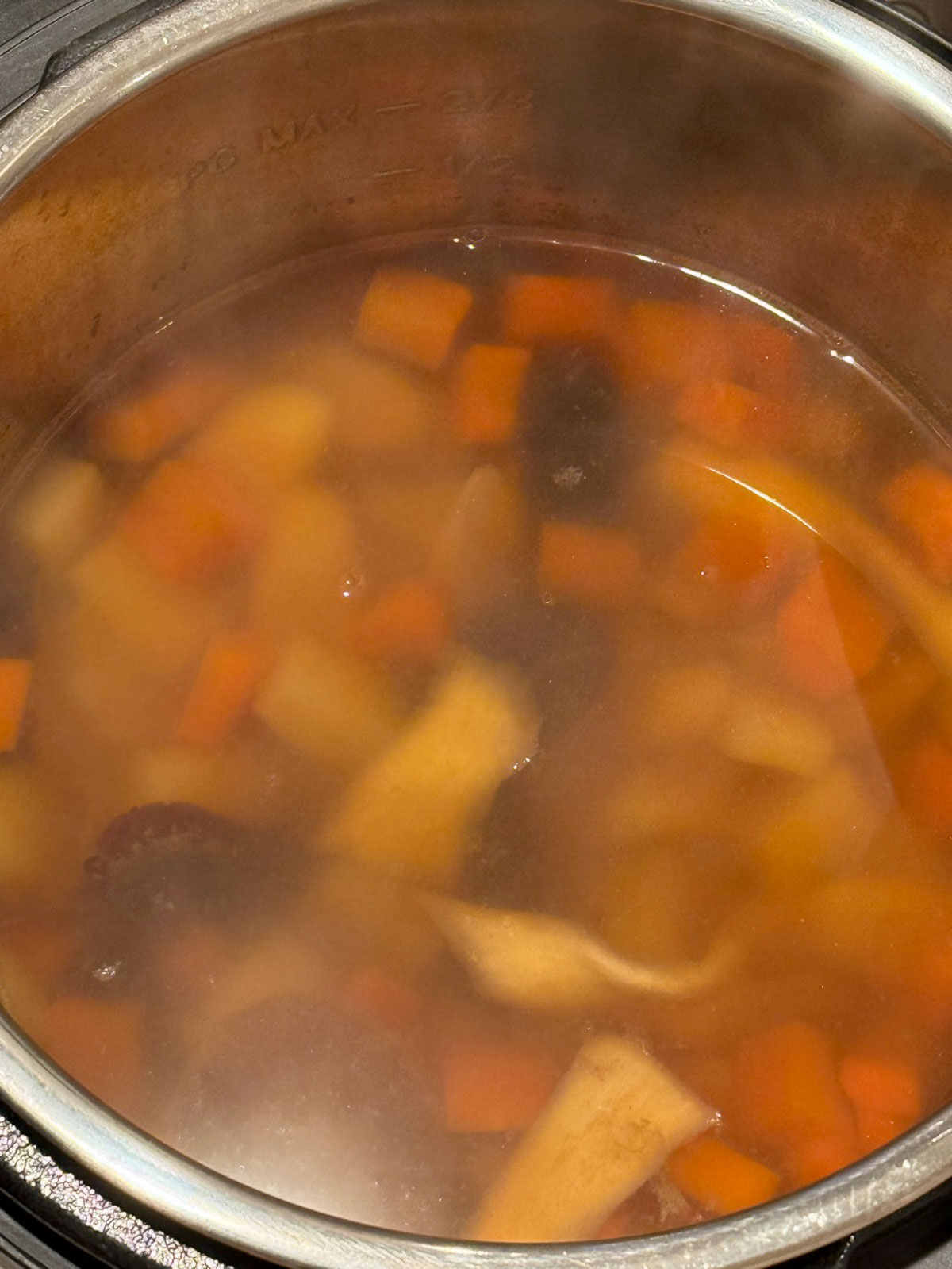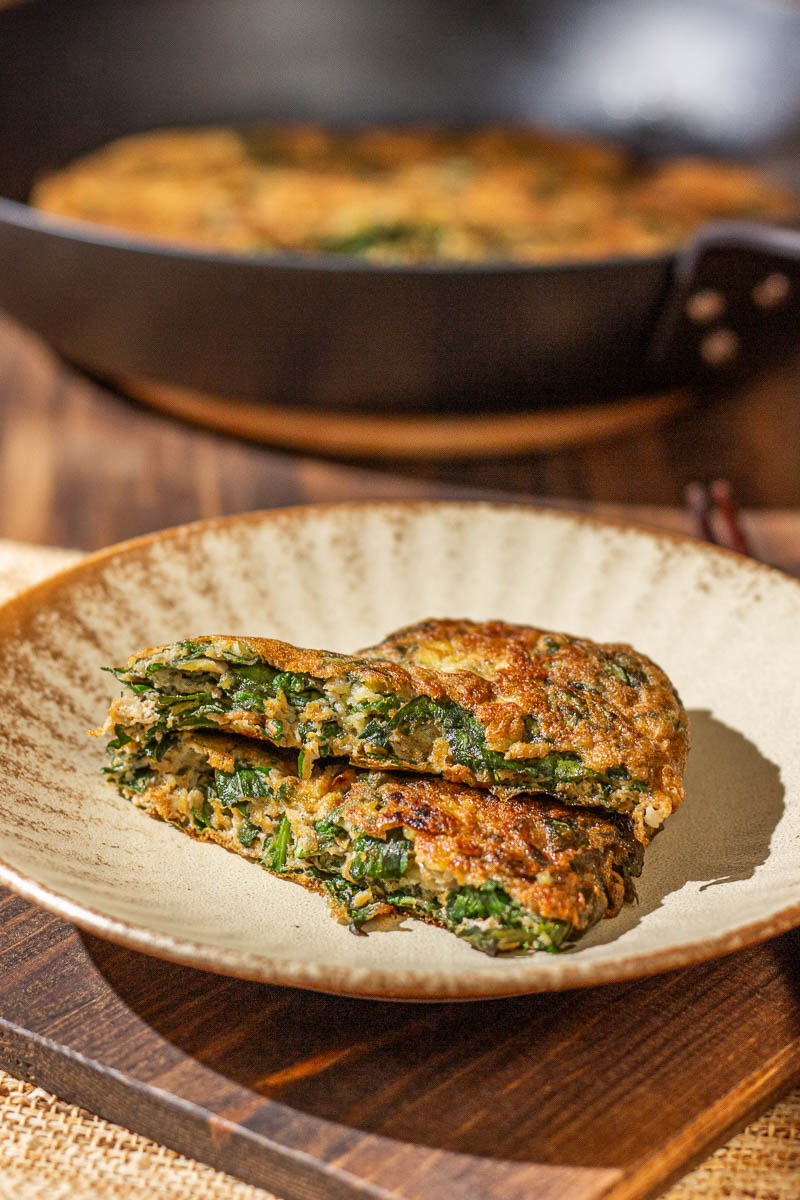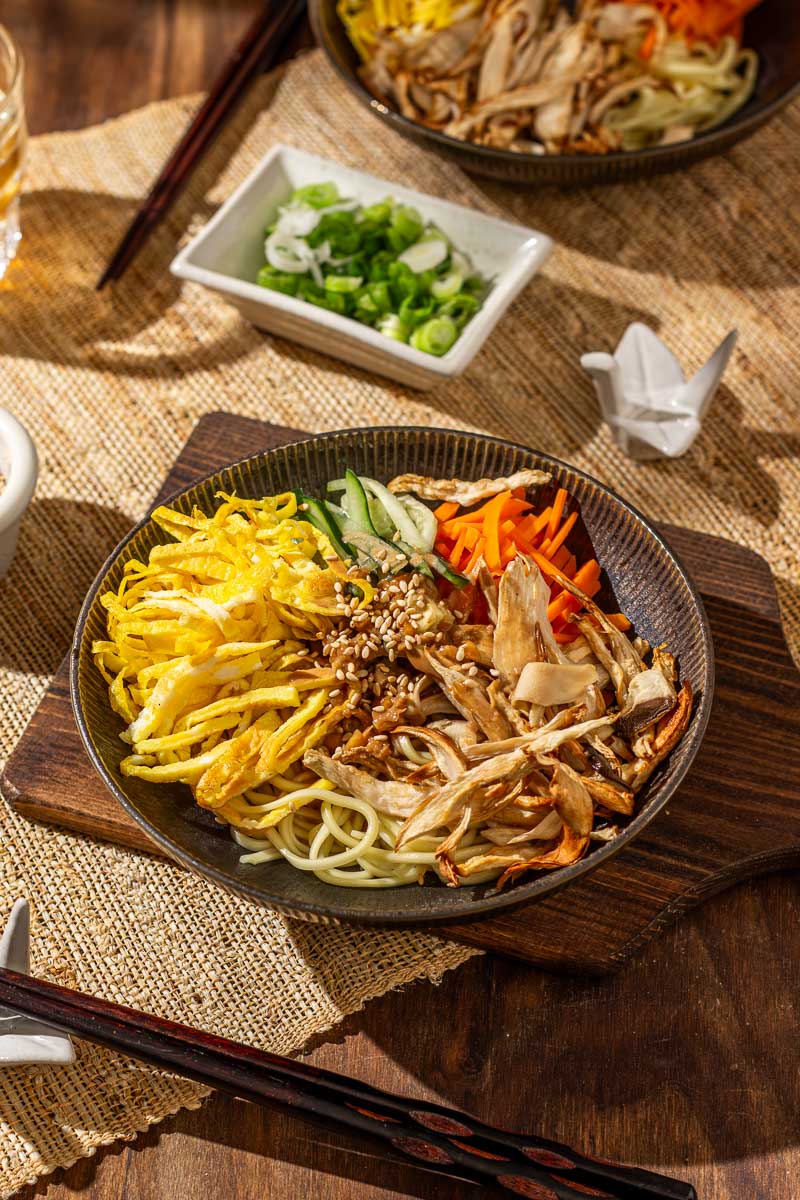Instant Pot Burdock Root Soup (素牛蒡湯)
Made with root vegetables, nuts, and dried jujubes, this earthy Burdock Root Soup is layered with natural sweetness and a hint of citrus!

Would You Like To Save This?
Burdock Root in Chinese
Burdock root is called Niú Bàng (牛蒡) or Niú Bàng Gēn (牛蒡根) in Chinese, with the former being more commonly used (Gēn or 根 means roots).
Feel like having something more substantial? Stir-Fried Burdock Root with Eggs is a quick and easy, crowd-pleasing, protein-packed dish, and Rice Cooker Meal with Burdock Root is another simple one-pot recipe (requires zero stove cooking)!
What is Burdock Root?

Burdock root, which is the root of the greater burdock plant Arctium Lappa, is—quite literally—a down-to-earth root vegetable with many medicinal and health benefits.
In Traditional Chinese Medicine (TCM), seeds of the greater burdock plant and its roots are considered to have a cooling effect when consumed, which can help reduce excess internal heat and fight inflammation in the body. As such, they have been used to treat sore throat, a sign of inflammation, in ancient China. To neutralize the cooling effect, burdock roots can be consumed cooked (heat is involved), or with neutral (like sesame seeds) or warm-hot foods (like ginger).


Traditional usage and health claims aside, burdock roots are undoubtedly packed with inulin, a soluble dietary fiber and a prebiotic (a food source for beneficial bacteria in the gut). Inulin is also a popular keto-friendly sweetener because of its lower glycemic index (the likelihood that food can increase blood sugar levels after ingesting; i.e., not as likely for burdock roots).
A one-cup serving of raw burdock root (about 118 grams) contains approximately 3.9 grams of fiber, which is about 11-18% of the daily requirement for an adult, or 22 grams per day at the minimum.
Growing up, my mom always told me how burdock roots would make you gassy. I can attest that it is true for me. I feel it right now as I type this after eating some burdock root for recipe testing. Eating burdock root is definitely a great way to terrorize whoever you are living with. 😂
What Does Burdock Root Taste Like?
Appearance: Burdock roots, native to Europe and Asia, look and smell a bit similar to ginseng (earthy, medicinal vibes?) and are sometimes referred to as oriental ginseng (actual ginsengs are mostly produced in North America, particularly in the American state of Wisconsin and the Canadian province of Ontario) while being much cheaper and with more culinary uses.
Taste and Texture: Raw burdock root tastes like a less bitter and more earthy version of daikon radish and is drier in texture than daikon radish. Depending on how it is cooked, burdock roots can taste quite similar to bamboo shoots (slightly sweet and earthy) but their texture can be quite dry and takes some chewing power (not as tender as bamboo shoots).
It is a well-known food ingredient in Chinese cooking but seems to be much more popular among Japanese home cooks, which is why you might see more Japanese recipes for burdock roots.
You will most likely find fresh burdock root only in local Asian markets or Asian supermarkets, while you will most likely find dried burdock root in health food stores.
Ingredients You’ll Need

- Burdock Roots: Similar to potatoes, burdock root’s skin is edible but I prefer to peel it.
- Carrot: So soft and delicious after being cooked! And adds a pop of color to the soup.
- Substitution: Not recommended.
- Potato: Adds substance to the otherwise very light soup.
- Substitution: You can substitute for corn, which adds sweetness without taking out the carbs.
- Cashews: Adds nuttiness and good fats for substance!
- Substitution: You can substitute for walnuts or use roasted cashews.
- Peanuts: Peanuts just go SO well in Chinese soups! I prefer using dry roasted peanuts with skin but you can also use those without skin.
- Substitution: Not recommended.
- Dried Jujubes (Chinese Red Dates): A staple ingredient in Chinese soups! Add another layer of sweetness to the soup.
- Substitution: I am using 3 jumbo red dates in this recipe but if you have smaller red dates, you can use 5-6 of them. You can toggle the metric system in the recipe card for the weight in grams to be precise.
- Dried Chinese Yam: Another staple ingredient in Chinese soups! They look like chalk but don’t worry, they will turn soft after!
- Substitution: Not recommended.
- Dried Tangerine Peel: Yet another staple ingredient in Chinese soups! Lifts the flavor (like lemon juice in dishes) and adds a refined, subtle aroma to the soup. It is also said to enhance digestion among other benefits.
- Substitution: Not recommended.
- Salt and plenty of water!
- (Optional Addition) Sesame Oil: Add a few drops to the soup as garnish and flavor enhancer!
Dried Chinese Yam




Step-By-Step Instructions
Here is a quick recipe run down and some visual instructions! The full instructions with ingredients are in the recipe card below.








Recipe Help and Common Questions
Burdock root can last 2-3 weeks if wrapped with damp paper towels and saran wrap (or in an airtight bag).
You can store any leftovers in an airtight container for 3 to 4 days. Reheat them in the microwave or on the stovetop.


Instant Pot Burdock Root Soup
Ingredients
Fresh Produce
- 2 sticks burdock root chopped
- 1 medium potato chopped
- ½ medium carrot chopped
- 2 tablespoons cashews raw
- 2 tablespoons peanuts dry roasted with skin
Dried Ingredients
- 4 slices dried Chinese yam
- 3 pieces dried jujubes (red dates)
- 2 pieces dried tangerine peel
Others
- 6 cups water
- 1 teaspoon salt
Equipment
Instructions
For prepping produce:
- Wash and peel the burdock roots. Then, chop them into thick slices.
- Wash and peel the potato. Then, chop them into cubes.
- Wash and peel the carrot. Then, chop them into cubes.
For prepping dried ingredients:
- Rinse the dried Chinese yam, dried red jujube dates, and dried tangerine peel to remove any dirt. Set aside.
For using Instant Pot's "Soup" setting:
- Add everything into the inner pot and set the Instant Pot to the "Soup" setting on high pressure for 15 minutes.
- After the soup function is completed, let the Instant Pot release pressure naturally for about 15-20 minutes.
- After 15-20 minutes, release any remaining pressure manually.
Serve and enjoy!
Would You Like To Save This?
Notes
Nutrition
Nutritional information is calculated to the best of my knowledge using MyFitnessPal (which has a more comprehensive ingredient database that includes Asian food items) and is an estimate. Actual nutrition will vary based on the cooking method and specific ingredients used.








This is a great recipe to get not just good food , but even better ”Chi” to make you healthier !
This is not just good food , but more ‘Chi’ to make you healthier !!